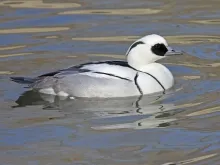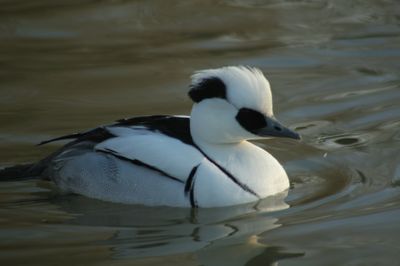
Smew (Mergellus albellus)
Species name
- Dutch name:
- Nonnetje
- English name:
- Smew
- German name:
- Zwergsäger
- French name:
- Harle piette
- Scientific name:
- Mergellus albellus
Scientific classification
- Order:
- Anseriformes
- Family:
- Anatidae
- Onderfamilie:
- Merginae
- Genus:
- Mergellus
Description
- Description:
Male:
White head with loose shaggy crest having narrow black ( in sunlight looks forest green iridescents) on sides, enlarged when crest is erected; black patch from base of bill to behind eye. Breast and belly white; with two thin black lines each side of chest forming a ‘V’ descending from black upper mantle. Flanks vermiculated grey and white; vent undertail-converts grayish, Upperparts black, becoming greyer on rump, uppertail-converts and tail; scapulars white. Upperwing blackish, with broad white panel on median converts, and narrow white bars formed by tips of greater converts and secondaries; underwing-converts whitish, with darker grey leading edge and flight feathers. Bill blackish. Legs and feet grey. Iris red-brown, but pale grey the older the birds.Female:
Chestnut head and hindneck, blackish on lores( brownish in summer), with contrasting white chin, throat, lower cheeks and foreneck; very slight crest on nape. Breast, flanks and ventral region grey; belly white. Upperparts darker grey, scapulars slightly lighter; rump, tail-converts and tail more silvery grey. Upperwing blackish, with small broad white panel on median converts, and narrow white bars formed by tips of greater converts and secondaries ; underwing-converts whitish, with darker grey leading edge and flight feathers. Bill blackish. Legs and feet grey. Iris red-brown.Juvenile:
Greyer on belly and broader white stripes on grater converts and secondaries. start to see adult plumage first winter but don’t get full adult plumage until 2nd winter.
Standard Measurements
- Body Length (cm):
- The male (drake) of the Smew measures approximately 38-43 centimeters. The female measures approximately 38-43 centimeters.
- Body Weight (grams):
- The male will weight about 545-725 gram. The female will weight about 545-725 gram.
The weight is notoriously variable and can only be used as indication!
- Note:
Smew are winter-hardy and suitable for mixed collections; a large water area containing natural food is preferred and a high-protein diet should be provided. They have been bred with some regularity, although they are not considered easy to rear. These small mergansers will nest in small raised barrels, hollow tree trunks or raised nestboxes, and may also lay in natural vegetation. One nest design uses a hollow tree trunk, approximately 1m high, with a roof, and a 10cm entrance hole about 23cm from the top, the floor being 30cm below the hole. This should be placed at the edge of the water with a ramp leading to the entrance hole. Eggs are usually laid May to June.
Hybrids reported with Goldeneye.
Sea ducks are preferably kept on a large area of clean, cold, deep water, at least some of which (preferably half the area) should be more than 60cm and preferably more than1m deep. As with other diving ducks, most species are relatively ungainly on land and ponds should have shallow sloping banks. Some cover along the pond edges will generally be appreciated. Preferred nesting sites vary greatly within this group, from open ground nesting to thick vegetation and tree holes.
These ducks generally need a higher-protein diet than most waterfowl species and high-protein pelleted diets specifically designed for seaducks are now available, although supplementation with fish may still be important particularly for breeding. Ducklings may be given high-protein starter floating pellets and mealworm, and provided with access to deep water for swimming from an early age.
- Breeding:
- The female Smew usually lays from 6-9 creamy white eggs and incubates them for 28-30 days.
- Artificial incubating:
The ideal relative humidity for incubating most waterfowl eggs is 55% (ground nesters) and 40% (cavity nesters). The temperature is usually 37.4°C. Set ventilation as recommended by the incubator manufacturer. Eggs must be turned, either automatically or by hand, a minimum of 4 times a day. As the duckling develops there is a loss of water from the egg and the air sac gets bigger. In normal development of an egg with a 28-30 days incubation, the air sac occupies about a third of it three days earlier. Cleanliness is vital and ideally eggs should be moved to a separate hatcher at this point, where the humidity should be increased to 65% and even higher once they have pipped internally.
- Bird banding:
- Recommended closed leg band ring size for the Smew is 9 mm.The leg band ring can only be applied on a young sea duck at around 11-12 days old.
- It doesn't matter what leg that you band, but it's good to have a consistent system. Suggested: Left leg = Female, Right leg = Male
- Rearingfeed:
-
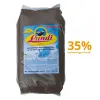
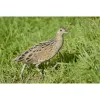

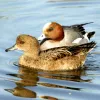


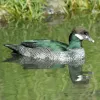 Floatable special rearing feed for all ornamental waterfowl species, even for problematic eaters. This ideally balanced complete feed with 35% protein content forms the basis for healthy growth and lifelong vitality. Made exclusively from wholesome and selected raw materials, Lundi Micro is also ideally suited for the year-round feeding of waterfowl.
Floatable special rearing feed for all ornamental waterfowl species, even for problematic eaters. This ideally balanced complete feed with 35% protein content forms the basis for healthy growth and lifelong vitality. Made exclusively from wholesome and selected raw materials, Lundi Micro is also ideally suited for the year-round feeding of waterfowl.
- Maintenance food:
-


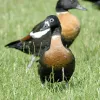


Floating full food for all sea ducks, green ducks, eider ducks and geese, especially in the moulting and breeding phase ideally suited. Packed with wholesome raw materials, natural vitamins and trace elements, this performance food with a protein content of 30% forms the basis for lifelong vitality.




Floating special complete food for sea birds with the highest nutritional requirements thanks to a particularly high protein content of 45%.
Ideal for daily feeding in animals that eat a lot of protein in their natural habitat. A must for "fish eaters".
- Regulation:
- Europese soort
- Regulation:
Het is niet verboden om deze vogels te houden die van nature in Nederland voorkomen, op voorwaarde dat deze vogels in gevangenschap zijn geboren; nakweek dus. Deze vogels zijn voorzien van een gesloten pootring. Het is wel verboden om deze vogels te houden die in het wild gevangen zijn. Alleen bepaalde instanties, zoals vogelasiels en vogelhospitalen, zijn bevoegd om jonge en gewonde wilde vogels te houden. Deze bescherming van vogels wordt vormgegeven door schadelijke handelingen te verbieden zoals:het doden, verwonden, vangen, bemachtigen en met het oog daarop opsporen van vogels (art. 9 Flora- en faunawet); het opzettelijk verontrusten van vogels (art. 10 Flora- en faunawet);het beschadigen, vernielen, uithalen, wegnemen en verstoren van nesten, holen of andere voortplantings- of vaste rust- of verblijfplaatsen van vogels (art. 11 Flora- en faunawet);en het zoeken, rapen, uit het nest nemen, beschadigen of vernielen van eieren van vogels (art. 12 Flora- en faunawet).
